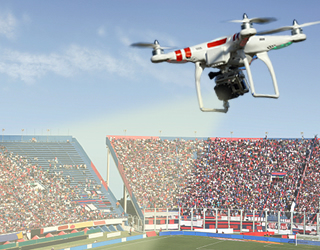 The use of drones has been a hot topic for years, but media coverage tends to focus on their surveillance and weapons-deployment capabilities. This is unfortunate: Drones aren't the sole province of law enforcement and military organizations, and their use offers clear benefits for industries that have nothing to do with these applications.
The use of drones has been a hot topic for years, but media coverage tends to focus on their surveillance and weapons-deployment capabilities. This is unfortunate: Drones aren't the sole province of law enforcement and military organizations, and their use offers clear benefits for industries that have nothing to do with these applications.
A rapid rise in the sporting world's demand for unmanned aerial vehicles underscores this point. Drones have a clear - and growing - role to play in sports photography and data collection.
Early Success Stories
For years, production crews have utilized drone technology to capture fast-moving bikers, skateboarders, skiers, snowboarders and other "extreme" athletes at the X-Games and other niche competitions. Since drones are highly maneuverable and lightweight, they're useful for capturing the sudden movements of acrobatic athletes on half-pipes and obstacle courses as well as the wide-field shots that contextualize slalom races, bike tours and other large-scale events.
The 2014 Winter Olympics provided a much higher-profile venue for drone-camera operators to show off their skills. Drones captured many of the aerial shots that illuminated the biathlon, Nordic, downhill and freestyle ski events. It's likely that drones will play an even more central role in the coverage of the next installment of the Olympics.
Current and Potential Applications
Aside from wide-field photography, drone technology has proven useful in a variety of other sports-related applications. A recent Monte Carlo auto-racing event used a drone "octocopter" to capture direct overhead shots of the raceway. This represented a clear improvement over the off-track, often awkward pole-mounted cameras on which photographers have relied until recently. Without the distortions of the former or the chaos of the latter, drones combine the visual reach of pole-mounted systems and the high-octane impact of hood-mounted cameras.
In other sports, drones fill a variety of practical -- if less dramatic -- roles. A recent CBS Sports report revealed that the Washington Nationals used at least one drone during their 2014 spring training sessions. The captured footage -- mostly straight-down shots of team members performing warm-up exercises -- will be incorporated into a promotional video at the team's home stadium, but future footage could be repurposed for training videos and other high-value uses. Current drone technology is robust enough to create reliable, "training-quality" video, and industry observers believe that the practice of using drones for team-building purposes will be common among U.S.-based pro sports teams within a few years.
Benefits and Efficiencies
Drones offer several clear benefits. First, they're extremely lightweight: Unlike pole-mounted assemblies and Steadicams, they can be disassembled and transported in a suitcase-sized carrier. Modern drones are also very easy to set up: An experienced operator can complete pre-filming preparations in just 10 or 15 minutes. Other aerial coverage options, including manned helicopters, may take hours to get off the ground. Since they're unmanned and lightweight, drones are also considerably safer than helicopters.
Looking to a Remote-Piloted Future
Despite their low cost, ease of use and relative safety, drones won't soon replace expensive, well-calibrated photography systems at professional arenas. At NFL and some Division I football stadiums, pricey, adaptive CableCam systems provide comprehensive coverage with which team owners and athletic directors see no reason to meddle. That said, lower-echelon sporting events -- especially in competitive high school football and baseball leagues -- can leverage drone technology for a fraction of the cost of CableCam systems or pole-mounted assemblies.
Modern drones do have a handful of drawbacks. The most troubling of these is the technology's insatiable appetite for power: Current models' batteries can only hold about 15 minutes of effective charge, and drones that must climb rapidly or perform acrobatic maneuvers may run for less time still. To address this issue, manufacturers and operators are experimenting with battery-exchange strategies and more effective charging mediums. Separately, drones aren't foolproof: Since they're piloted by a human operator, the potential for error is always present. No authoritative body keeps reliable statistics on drone crashes, but these events do happen. While crashes or malfunctions pose minimal safety risks for athletes and spectators, they can be expensive and inconvenient for operators and viewers alike.
Drones already provide reliable, affordable assistance for sports photographers and production crews that lack access to more expensive equipment. As their cost continues to slide, it's likely they'll appear in an ever-widening range of applications. Soon enough, the sky really could be the limit for sporty drones.
